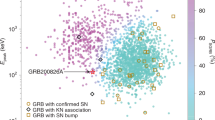Abstract
Observing the famous high-mass, eccentric X-ray and \(\gamma\)-ray binary PSR B1259–63/LS 2883 with Chandra, we detected X-ray emitting clumps moving from the binary with speeds of \(\sim 0.1\,c\), possibly with acceleration. The clumps are being ejected at least once per binary period, 3.4 years, presumably around binary periastrons. The power-law spectra of the clumps can be interpreted as synchrotron emission of relativistic electrons. Here we report the results of 8 observations of the clumps in 2011–2017 (two binary cycles) and discuss possible interpretations of this unique phenomenon.


Similar content being viewed by others
Notes
The second such binary, PSR J2023+4127/MT91 213, was identified by Lyne et al. (2015). Its binary period of \(\sim 50\) years is, however, too long to study the orbital dependence in our lifetime.
References
Abdo AA, Ackermann M, Ajello M et al (2011) Discovery of high-energy gamma-ray emission from the binary system PSR B1259–63/LS 2883 around periastron with Fermi. ApJ 736:L11
Barkov MV, Bosch-Ramon V (2016) The origin of the X-ray-emitting object moving away from PSR B1259–63. MNRAS 456:L64
Bogovalov SV, Khangulyan DV, Koldoba AV et al (2008) Modelling interaction of relativistic and non-relativistic winds in binary system PSR B1259–63/SS 2883—I. Hydrodynamical limit. MNRAS 387:63
Chernyakova M, Abdo A, Neronov A et al (2014) Multiwavelength observations of the binary system PSR B1259–63/LS 2883 around the 2010–2011 periastron passage. MNRAS 439:432
Chernyakova M, Neronov A, van Soelen B et al (2015) Multi-wavelength observations of the binary system PSR B1259–63/LS 2883 around the 2014 periastron passage. MNRAS 454:1358
Dubus G (2013) Gamma-ray binaries and related systems. A&A Rev 21:64
H.E.S.S. Collaboration, Abramowski A, Acero F et al (2013) H.E.S.S. observations of the binary system PSR B1259–63/LS 2883 around the 2010/2011 periastron passage. A&A 551:A94
Johnson TJ, Wood KS, Kerr M et al (2018) A luminous and highly variable gamma-ray flare following the 2017 periastron of PSR B1259–63/LS 2883. ApJ 863:27
Kargaltsev O, Pavlov GG, Durant M et al (2014) Variable nebula of PSR B1259–63 resolved by Chandra. ApJ 784:124
Khangulyan D, Aharonian F, Bogovalov SV et al (2012) Post-periastron gamma-ray flare from PSR B1259–63/LS 2883 as a result of comptonization of the cold pulsar wind. ApJ 752:L17
Kong SW, Cheng KS, Huang YE (2012) Modeling the multiwavelength light curves of PSR B1259–63/LS 2883. II. The Effects of anisotropic pulsar wind and Doppler boosting. ApJ 753:127
Lyne AG, Stappers BW, Keith MJ et al (2015) The binary nature of PSR J2032+4127. MNRAS 451:581L
Miller-Jones JCA, Deller AT, Shannon RM et al (2018) The geometric distance and binary orbit of PSR B1259–63. MNRAS 479:4849
Negueruela I, Ribó M, Herrero A et al (2011) Astrophysical parameters of LS 2883 and implications for the PSR B1259–63 gamma-ray binary. ApJ 732:L11
Pavlov GG, Chang C, Kargaltsev O (2011) Extended emission from the PSR B1259–63/SS 2883 binary detected with Chandra. ApJ 730:2
Pavlov GG, Hare J, Kargaltsev O et al (2015) An extended X-ray object ejected from the PSR B1259–63/LS 2883 binary. ApJ 806:192
Shannon RM, Johnston S, Manchester RN (2014) The kinematics and orbital dynamics of the PSR B1259–63/LS 2883 system from 23 yr of pulsar timing. MNRAS 437:3255
Tavani M, Arons J (1997) Theory of high-energy emission from the pulsar/Be star system PSR 1259-63. I. Radiation mechanisms and interaction geometry. ApJ 477:439
Tavani M, Lucarelli F, Pittori C et al (2010) AGILE detection of transient gamma-ray emission from the PSR B1259-63 region. ATel. No. 2772
Acknowledgements
Support for this work was provided by NASA through Chandra Awards GO5-16065, GO7-18056 and DD7-18088 issued by the Chandra X-ray Center, which is operated by the Smithsonian Astrophysical Observatory for and on behalf of the National Aeronautics Space Administration under contract NAS8-03060.
Author information
Authors and Affiliations
Corresponding author
Additional information
Publisher's Note
Springer Nature remains neutral with regard to jurisdictional claims in published maps and institutional affiliations.
This paper is the peer-reviewed version of a contribution selected among those presented at the Conference on Gamma-Ray Astrophysics with the AGILE Satellite held at Accademia Nazionale dei Lincei and Agenzia Spaziale Italiana, Rome on December 11–13, 2017.
Rights and permissions
About this article
Cite this article
Pavlov, G.G., Hare, J. & Kargaltsev, O. High-speed ejecta from the gamma-ray binary PSR B1259–63/LS 2883. Rend. Fis. Acc. Lincei 30 (Suppl 1), 125–129 (2019). https://doi.org/10.1007/s12210-019-00765-0
Received:
Accepted:
Published:
Issue Date:
DOI: https://doi.org/10.1007/s12210-019-00765-0




